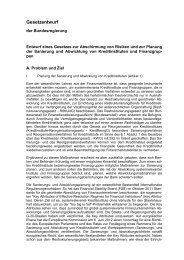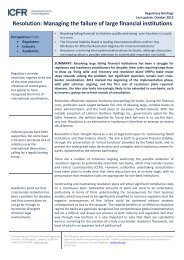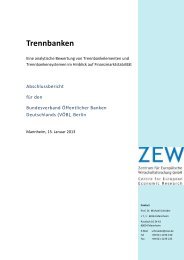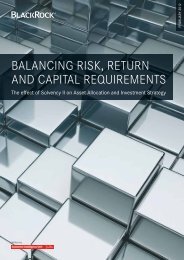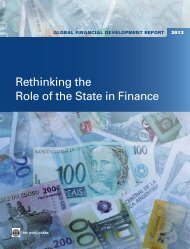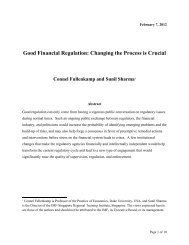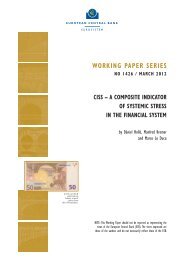A Proposal for the Resolution of Systemically Important Assets and ...
A Proposal for the Resolution of Systemically Important Assets and ...
A Proposal for the Resolution of Systemically Important Assets and ...
Create successful ePaper yourself
Turn your PDF publications into a flip-book with our unique Google optimized e-Paper software.
<strong>the</strong>n it gets treated as being sold <strong>and</strong> repurchased each day, so that as far as its capital<br />
requirementconcerned,itissubjecttomarketrisk<strong>for</strong>onlyoneday.<br />
Thistrans<strong>for</strong>mation<strong>of</strong>alongtermassetintoanovernightassetisprimarilybecause<strong>of</strong><br />
<strong>the</strong> repo financier’s right to take over <strong>the</strong> asset in case <strong>of</strong> failure <strong>of</strong> <strong>the</strong> repo counterparty.<br />
However, as explained above, in many cases repo financiers <strong>the</strong>mselves cannot own <strong>the</strong>se<br />
assets in <strong>the</strong> long run <strong>and</strong> must liquidate <strong>the</strong>m upon failure <strong>of</strong> <strong>the</strong>ir repo counterparty.<br />
There<strong>for</strong>e, <strong>the</strong> migration <strong>of</strong> <strong>the</strong> MBS from <strong>the</strong> banking to trading book lowers <strong>the</strong> capital<br />
requirementagainstitthroughout<strong>the</strong>financialsystem,sincenoinstitutionisholdingcapital<strong>for</strong><br />
a scenario where <strong>the</strong>re is systemic illiquidity under which some institution — most likely an<br />
institutionwhichincurredahugeilliquiditydiscountin<strong>the</strong>firesale<strong>of</strong><strong>the</strong>asset—musthold<br />
<strong>the</strong>asset<strong>for</strong><strong>the</strong>longrun.<br />
Suchdistortionspushcounterpartiestowarddesigningcomplexproductsthatcanhelp<br />
shift assets from <strong>the</strong> banking to <strong>the</strong> trading book, which are <strong>the</strong>n financed using shortterm<br />
reposin<strong>the</strong>repomarket,awayfrom<strong>the</strong>monitoring<strong>of</strong>regulators<strong>and</strong>atsubstantiallylower<br />
capitalrequirements.Theeffectiveoutcomeistremendousliquidityinrepomarkets<strong>for</strong><strong>the</strong>se<br />
productsingoodtimes,withsystemicstress<strong>and</strong>fragilitywhen<strong>the</strong>productsareanticipatedto<br />
experiencelosses.Theexpansion<strong>of</strong>safeharbortorepotransactionswithunderlyingmortgage<br />
basedassetsin<strong>the</strong>BankruptcyAct<strong>of</strong>2005hasthusbeencitedasone<strong>of</strong><strong>the</strong>reasons<strong>for</strong><strong>the</strong><br />
growthinmortgagebasedderivativesover<strong>the</strong>periodfrom2005to2007.<br />
TheDFAessentiallytreatsQFCs<strong>the</strong>sameway<strong>the</strong>FDICtreats<strong>the</strong>minreceivershipsnot<br />
coveredby<strong>the</strong>Act.Thatis,at<strong>the</strong>end<strong>of</strong><strong>the</strong>firstbusinessdayafterareceivershipcommences,<br />
counterpartieswouldbeabletoexercise<strong>the</strong>irrightsagainst<strong>the</strong>CFCsuchastoterminate,net<br />
out,set<strong>of</strong>f<strong>and</strong>applycollateralwithrespecttoall<strong>the</strong>irQFCs.There<strong>for</strong>e,although<strong>the</strong>provision<br />
<strong>of</strong>asafeharborunder<strong>the</strong>DFAisnotidenticaltothat<strong>of</strong><strong>the</strong>bankruptcycode,QFCsstillbenefit<br />
from special protection. An exception is that until <strong>the</strong> end <strong>of</strong> <strong>the</strong> first business day after<br />
commencement,<strong>the</strong>FDICwouldbeallowedtotransferall(<strong>and</strong>onlyall)<strong>of</strong><strong>the</strong>QFCsbetween<br />
<strong>the</strong> CFC<strong>and</strong> a given counterparty. Although such exceptions to <strong>the</strong> safe harbor clause make<br />
some sense to <strong>the</strong> extent <strong>the</strong> systemic risk <strong>of</strong> financial institutions might vary from one<br />
situation to <strong>the</strong> next, a better approach would be (Acharya, Adler <strong>and</strong> Richardson, 2011) as<br />
follows:<br />
<br />
1) QFCsthatareliquidshouldkeep<strong>the</strong>exemption.LiquidQFCswillcauselesssystemic<br />
risk in fire sales, yet still allow counterparties to manage <strong>the</strong>ir risk without <strong>the</strong><br />
uncertainty generated by <strong>the</strong> bankruptcy <strong>of</strong> a SIFI. Moreover, in order to get <strong>the</strong><br />
exemption,counterpartieswillhaveanincentivetotradeinliquidQFCs.<br />
<br />
2) QFCsthatareilliquid—orpotentiallyilliquid(suchasrepocontractsonMBSs)—<br />
shouldbesubjectto<strong>the</strong>ordinaryrules<strong>of</strong>bankruptcyincluding<strong>the</strong>automaticstay.<br />
The systemic risk underlying fire sales would be avoided, especially given that<br />
complex, illiquid transactions are more difficult to unwind. Of course, this would<br />
comeat<strong>the</strong>cost<strong>of</strong>generalliquidity<strong>of</strong><strong>the</strong>counterparties<strong>and</strong>impact<strong>the</strong>irabilityto<br />
13



